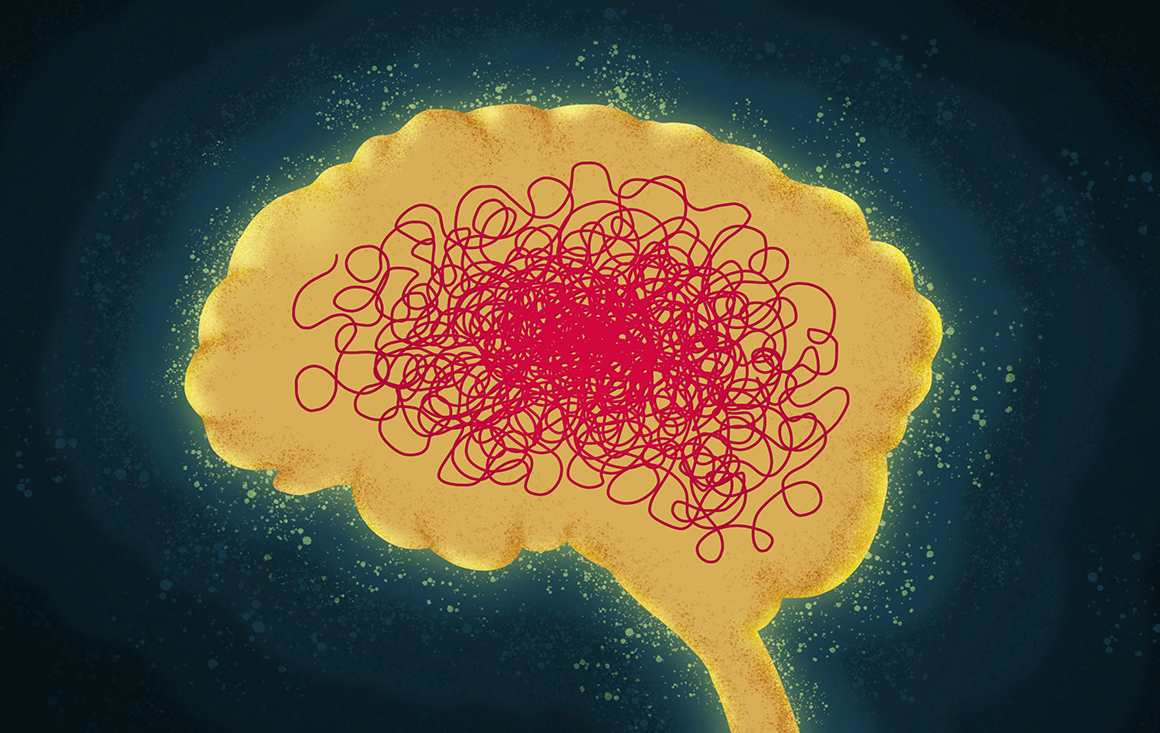
Your Brain on Anxiety
Depression isn’t real. Just get over it.
Many of the 57 million people in the US who live with a mental illness have heard some variation of these phrases born out of an erroneous belief that these conditions are somehow a choice or moral failing.
But what if science could point to not only the specific parts of the brain where these disorders originate, but also the specific cells?
Understanding the biological origins of mental illness has become an increasingly hot area of research in the last decade, with scientists hopeful that advances could improve treatments and decrease social stigma.

Lindsay Halladay
At Santa Clara University’s Neural Circuits, Systems, & Behavior Lab, associate professor of neuroscience Lindsay Halladay leads a team of student researchers in investigating exactly these questions.
“There’s a lot of suffering out there, and it seems that conditions like addiction and anxiety touch nearly everyone to some extent. This felt like a natural place to make my own contribution to understanding the brain pathways that are involved in these disorders,” she says.
Her research at SCU began with exploring the neural roots of addiction using mouse models, but recently, she’s turned to the bigger mystery of why some people are more likely to experience mental disorders than others. After years of research, the Halladay Lab may have figured out a crucial “when” and “where.”
The “when” and “where”
Consider an adult brain with substance use disorder or generalized anxiety. If there was an experiential cause of that disorder, when did it first develop? Obviously, Halladay says, every individual has a unique set of past experiences, so identifying factors that increase susceptibility to mental disorders before they develop is key to preventative care.
“There is a lot we don’t know about how the adult brain becomes the adult brain,” she says. Some of the most important neurodevelopmental changes occur around birth and during puberty when hormones play a huge role in differentiating the brains of males and females.
“Sex difference” is a relatively new concept in the field of neuroscience. It was only 20 years ago that women were first included in clinical studies despite the fact that women report mental health issues at higher rates than men. These disparities extend down to the cellular level where specific areas of the brain are sexually dimorphic, or have different amounts or types of cells depending on the person’s sex.
One of these sexually dimorphic areas that Halladay’s lab is focused on is the bed nucleus of the stria terminalis, which is more commonly known as the “extended amygdala.” This network in the brain connects the central amygdala, the cortical regions, and the body’s stress response system—it’s heavily involved with fear and reward learning and decision-making. The extended amygdala also undergoes key development in the first few months of an infant’s life when sex hormones impact the brain’s development.
Through mouse model research, Halladay and her team found that infants who experience early-life stress will over-activate their stress response system. As a result, other areas of the brain don’t develop properly. If that stress is chronic, these changes can become permanent.
Because of the developmental timing of this early-life stress, different cells in the extended amygdala are affected in males and females, which may help explain those adulthood disparities in mental health disorders.

“Having a lively group of students in the lab is really great for keeping me excited about the work, but also focused on what we're really doing and why it really matters,” Halladay (center) says.
Probing the limits
Figuring out the “when” and “where” of mental illness isn’t the end of Halladay’s research.
To better understand the impact of early-life stress on gender disparities in mental illness, she wants to pinpoint whether this stress occurs during some particular time in the female brain’s development, or whether it affects specific cells that are more important for female-biased systems.
“The more we know about behavioral or symptomatic differences, the more we could shape the way that treatments are designed,” she says. “Perhaps down the road, you could tailor pharmaceuticals toward men or women. While clinical trials for something like that seem far off, I would have said the same thing about brain implants a couple of years ago, but here they are.”
But even in her lab, small discoveries might have larger effects on the field, which Halladay credits to the insightful questions from her passionate student researchers, like “Why are we doing the things we’re doing?” or “What’s the actual benefit?”
“For example, given that the mice typically used in these experiments are bred to be genetically homogenous, we asked ourselves, are we even using the right mice to predict human behavior?” she explains. “We began working with more genetically diverse mice, and we’ve already noticed differences in their behavior, which could have huge implications on how research on this topic is conducted.”
The lab has also found unexpected connections between early-life stress and slower wound healing, which has turned their interest to how the immune system connects with the brain.
After three years of working in Halladay’s lab, Janet Ronquillo ’23 says this approach to new questions and ways of doing things has been crucial in the development of this growing field—an exciting process to be a part of so early in her career.
This year, she’ll be continuing at the Halladay Lab as a post-graduate researcher with hopes to apply for graduate school or medical school in the next year.
“Dr. Halladay has made so many great connections for us students. My lab mate was able to shadow people at a hospital, and by attending neuroscience conferences, I met these amazing Ph.D. students. In general, working in this lab has something for everyone whether you’re pre-med or going into research.”